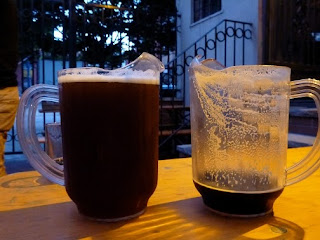
 [link to Evil Twin podcast page]
[link to Evil Twin podcast page]

Back in July,
Beer Street in Williamsburg hosted a few Danish craft brewers for a tasting event, including Jeppe of
Evil Twin, the identical twin brother of Mikkel of
Mikkeller. Mikkel and Tør from To Øl were there, too. (Or tøø, if you prefer.)
Both brothers have a similar type of brewing company -- they're gypsy brewers. That means that they don't have their own brewing facility. Instead, they brew their beers, or have them brewed, at different breweries, all over the world. Though, Jeppe does most of his brewing in Europe.
 |
| Jeppe is 2nd from the left. |
This method has a lot of advantages over a "brick and mortar" operation. First off, there is nowhere near the incredible financial obstacles of buying or even leasing a commercial brewery, and all the complications, government licenses, taxes, etc. that an owner of a brewery has to deal with. No worrying about equipment maintenance. There is no rent. There are no labor costs.

Basically, you have your recipe, you book a brew date with a brewery that has extra capacity (as most do -- few breweries are brewing 24/7), you order your materials to be delivered, then you go and brew! Or you can direct the brewing to the trusted master brewer of that particular brewery.
The brewery takes care of bringing the beer from raw ingredients to bottles or kegs shrinkwrapped on pallets. You don't have to fill a hot liquor tank, couple a hose, shovel spent grain or do any of the other inglorious work involved in brewing. They take care of the dirty work, and you pay them the wholesale cost of the beer, just as if you were buying the brewery's own product. And then you distribute, promote, sell and enjoy!


Aside from the obvious advantages of not having all the hassles of owning, paying for, and managing a complex business like a brewery, it also frees up a gypsy brewer to be very creative and flexible. The brewer can use different facilities that are best suited to which ever particular style of beer which he wants to brew. Brewing systems, though technically much the same, can have significant subtle differences that can affect everything from mash efficiency to yeast flocculation, depending on the type of beer and its particular ingredients.

Gypsy brewing is growing -- even
The Atlantic wrote about the subject! Jeppe and his brother have been gypsy brewing leaders, joined by other high quality, accomplished brewers, such as the boys at
To Øl, Brian of
Stillwater, Dan and Martha of
Pretty Things, among others -- often times collaborating with one another, This innovative generation of hyper-creative, quality-minded, imaginative young brewers are blazing the way and making the craft beer world all the more interesting, exciting and delicious!













 [link to podcast page]
[link to podcast page]








































